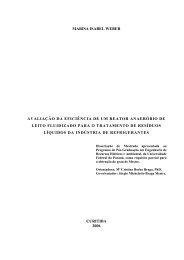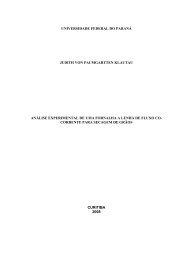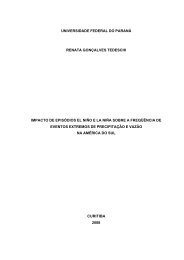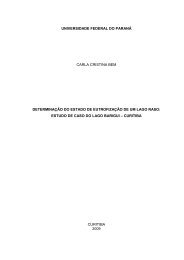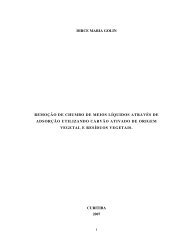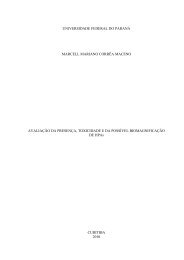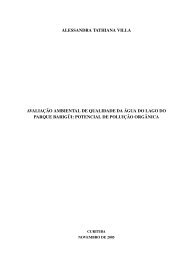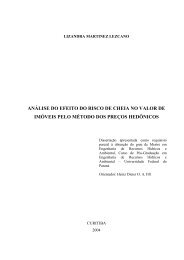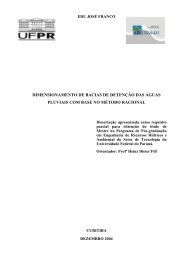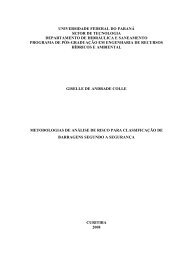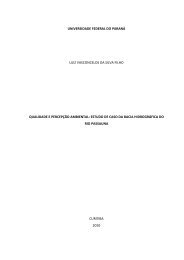Modelagem Física e Computacional de um Escoamento Fluvial
Modelagem Física e Computacional de um Escoamento Fluvial
Modelagem Física e Computacional de um Escoamento Fluvial
You also want an ePaper? Increase the reach of your titles
YUMPU automatically turns print PDFs into web optimized ePapers that Google loves.
(ROSMAN 34 e ABBOTT; LARSEN 35 apud ROSMAN, 1989):<br />
uiuj = uiuj + λ2 k<br />
12<br />
∂ui<br />
∂xk<br />
∂uj<br />
∂xk<br />
+ λ2 t<br />
12<br />
∂ui<br />
∂t<br />
39<br />
∂uj<br />
∂t + O (λ 4 k, λ 4 t , λ 2 k, λ 2 t ) · D.A.O. , (3.38)<br />
on<strong>de</strong> D.A.O. significa <strong>de</strong>rivadas <strong>de</strong> alta or<strong>de</strong>m. Em 1985, ALDAMA chegou a resultado<br />
semelhante através da separação, isto é, chamando <strong>de</strong> u ′ i a componente <strong>de</strong> pequena escala<br />
ou não resolvível <strong>de</strong> ui e <strong>de</strong> ui a componente <strong>de</strong> gran<strong>de</strong> escala ou resolvível, escreve-se:<br />
uiuj = ui uj + ui u ′ j + u′ i uj + u ′ i u′ j<br />
. (3.39)<br />
Contrastando com as promediações <strong>de</strong> Reynolds, temporal relaxada e estatística, não há<br />
postulados como 3.5 para o caso da filtragem. Assim, os termos cruzados uiu ′ j<br />
não são<br />
nulos, e ui = ui. Entretanto, ALDAMA (1985) provou que a seguinte série é assintótica:<br />
uiuj = uiuj + λ2 k<br />
12<br />
∂ui<br />
∂xk<br />
∂uj<br />
∂xk<br />
+ λ2 t<br />
12<br />
∂ui<br />
∂t<br />
∂uj<br />
∂t + u′ i u′ j<br />
, (3.40)<br />
on<strong>de</strong> os termos <strong>de</strong> mais alta or<strong>de</strong>m estão embutidos em u ′ iu′ j . Analisando as equações<br />
(3.38), (3.39) e (3.40), fica claro que os termos <strong>de</strong> filtragem, isto é, os termos envolvendo<br />
λi e λt, trazem em si informação sobre as componentes <strong>de</strong> gran<strong>de</strong> escala do escoamento e,<br />
<strong>de</strong>vido aos termos cruzados, também sobre a interação entre as componentes <strong>de</strong> gran<strong>de</strong> e<br />
<strong>de</strong> pequena escala. Esse é <strong>um</strong> resultado teórico muito po<strong>de</strong>roso, cuja discussão está além<br />
dos objetivo <strong>de</strong>ste texto.<br />
Substituindo a expansão (3.40) acima na equação (3.37), obtém-se:<br />
∂ui<br />
∂t<br />
∂<br />
+ (ui uj) = F −<br />
∂xj<br />
∂<br />
2 λk ∂xj 12<br />
∂ui<br />
∂xk<br />
∂uj<br />
∂xk<br />
+ λ2 t<br />
12<br />
∂ui<br />
∂t<br />
∂uj<br />
∂t + u′ iu′ <br />
j<br />
. (3.41)<br />
34 ROSMAN, P.C.C.,Mo<strong>de</strong>ling shallow water bodies via filtering techniques, Ph.D. thesis, Department<br />
of Civil Engineering, Massachusetts Institute of Technology, 1987.<br />
35 ABBOTT, M.B. and LARSEN,J., Mo<strong>de</strong>lling circulation in <strong>de</strong>pth-integrated flows. Part2: A reconciliation,<br />
Journal of Hydraulic Research, IAHR 23(5), 1985.



